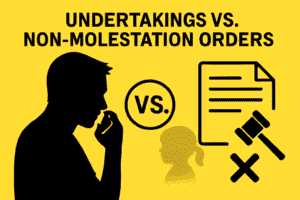Fact-Finding Hearings – Understanding the Judge’s Impact
In the intricate landscape of family law, the findings derived from the Fact-Finding hearing wield significant influence, setting the stage for subsequent legal proceedings.
The critical nature of these findings becomes evident as we delve into their multifaceted impact on various aspects of family law cases.
Key Takeaways:
- Fact-Finding Hearings set the foundation for child arrangements, finances, and future hearings.
- The judge’s findings on credibility and evidence carry lasting weight in your case.
- Protective orders (such as Non-Molestation Orders) can be issued based on findings.
- Clear, organised evidence (e.g. using a Scott Schedule) strengthens your position.
- Early preparation helps streamline the final hearing and avoid wasted time.
Facing a fact-finding hearing? Message us on WhatsApp now and get tailored advice before it’s too late.
Quick Navigation:
1. Child Arrangements and Custody
When child custody is in contention, the Judge’s findings serve as a compass, guiding the determination of the most suitable parent or guardian. Safety concerns unveiled during the hearing act as pivotal factors, prompting the Judge to adjust child arrangements to ensure the safety and well-being of the child.
2. Financial Settlements and Fact-Finding Hearings
In cases entangled with financial intricacies, the Judge’s findings hold sway over the distribution of assets, spousal maintenance, and the formulation of child support arrangements. Uncovering financial misconduct or asset concealment during the Fact-Finding hearing can significantly alter the trajectory of the final division of assets and the structuring of financial support.
3. Domestic Abuse and Protection Orders
The revelations of domestic abuse or violence during the court process can precipitate the issuance of protective orders, such as non-molestation or occupation orders. These legal instruments are designed to shield the victim from further harm and dictate living arrangements for the parties involved during ongoing proceedings and beyond.
Allegations of abuse can change everything — get WhatsApp support today to prepare a calm, fact-based defence.
4. Impact on Negotiations and Settlements
Beyond the courtroom, the Judge’s findings exert a profound impact on the dynamics of negotiations and settlements between the involved parties. The discrediting of one party’s allegations during the Fact-Finding hearing may prompt a reconsideration of positions, fostering a more amenable environment for negotiating resolutions rather than proceeding to the final hearing.
5. Weight of Evidence and Credibility
A cornerstone of the Fact-Finding hearing lies in the Judge’s assessment of the credibility of the parties and the evidence presented. This evaluation significantly influences the Judge’s overall judgment during the final hearing. A party whose allegations are found credible stands on a more robust footing in the subsequent legal proceedings.
For many dads, the most important tool for presenting these allegations clearly is the Scott Schedule, which organises each allegation and response into a format the court can easily review.
Your credibility is everything in court. WhatsApp us now to learn how to present evidence that strengthens your case.
6. Efficiency of the Final Hearing
By addressing contested allegations and disputed facts during the Fact-Finding hearing, the subsequent final hearing gains a valuable sense of focus and efficiency. The Judge’s findings act as a beacon, providing clarity on the relevant issues, thereby narrowing down the matters that require further consideration. This, in turn, reduces the time and resources required for the final hearing, fostering an environment of expedited and streamlined legal proceedings.
Conclusion
In conclusion, the Judge’s findings emerging from the Fact-Finding hearing cast a long shadow over the outcome of the subsequent final hearing. These findings, serving as the bedrock upon which final decisions are crafted, ensure that the court’s orders are not only legally sound but also well-informed, fair, and fundamentally aligned with the best interests of all parties involved, particularly the vulnerable individuals, such as children, who are central to family law cases.
👉 Learn more about how we can support you or book a free consultation today
🧠 Insider Insight: Lach, our founder, is a qualified social worker who used to write Section 7 reports for CAFCASS — the very reports that influence court outcomes. Now he helps dads respond to them. Learn more about Lach’s background.




